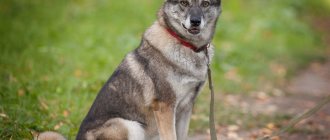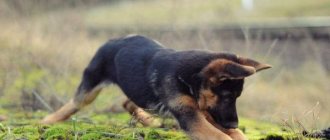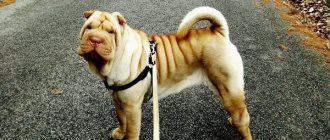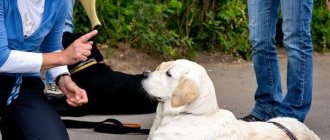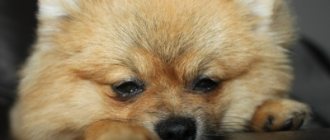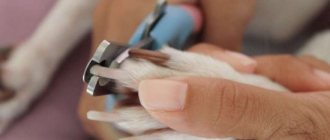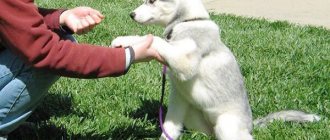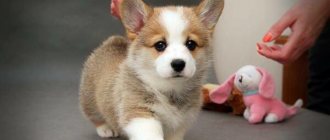The right approach to raising a puppy allows you to raise an obedient dog that will delight its owner with good behavior. It is important to start training your four-legged friend as soon as possible. Below you can find information on how to properly conduct training and practice commands with your pet.
You should start training your puppy from the moment he is 12-14 weeks old.
At what age should you start training a puppy and how long should you train?
At what age can you train a dog? It is advisable to start training your dog at 12 weeks of age. It is during this period that the puppy must become familiar with a large number of situations, commands and other animals and people.
It is believed that puppies under 5 months of age have the most developed memory.
At this time, it is worth teaching your pet to distinguish between safe and dangerous. It is important to conduct classes systematically. In this case, the training time should not exceed 25 minutes. Attention! After the specified period of time, the puppy will get tired and make mistakes. Such training will bring neither pleasure nor benefit.
Popular questions and answers
We talked with dog trainer Zlata Obidova about what other points should be taken into account when training a puppy .
At what age can a puppy be taught commands?
You can teach your puppy commands from the age of 4 months, when all vaccinations have been completed and quarantine has passed. It is best to train your dog in the morning and evening before the main meal, then the pet will be more willing to follow commands.
How often should a puppy be taught commands?
It is advisable to carry out training every day so that the pet does not lose the habit. But it shouldn't take much time. Don't repeat each command a hundred times. 3 – 5 repetitions are enough, after which take a break.
How to reward a dog for following a command?
Treats that she loves.
But it is important to remember that the interval after executing the command and receiving the treat should not be more than 3 seconds. When the dog begins to follow commands well, you need to wean it off treats. Give a treat not for each completed exercise, as was the case in the beginning, but after 2 - 3 correctly executed commands. Instead of treats, you can pet and praise. Sources
- Khainovsky A.V., Goldyrev A.A. On modern methods of training service dogs // Perm Agrarian Bulletin, 2020 https://cyberleninka.ru/article/n/o-sovremennyh-metodikah-dressirovki-sluzhebnyh-sobak
- Panksepp J. Affective neuroscience: The foundations of human and animal emotions // New York, Oxford University Press, 2004 – 408 p.
How to properly allocate time and effort to training a dog
Proper distribution of time and effort will increase the effectiveness of teaching your four-legged friend commands and skills. Experts, first of all, recommend paying attention to:
- Duration of training. The most effective training is the first 15-20 minutes.
- Systematic training will be the key to success. It is important not to miss classes so that the dog does not forget the commands learned the day before.
- Repetition of what has been learned, allowing you to consolidate the learned skills.
Each workout should be divided into blocks, the duration of which does not exceed 10 minutes. Between blocks, the owner should play games with his four-legged friend to allow the dog to relax.
What to teach your dog in the first months
In the first three months, the baby must learn a lot. The very first and simplest thing is that he must respond to his nickname. To achieve this, you should call the four-legged dog by name as often as possible: during meals or to give a treat or toy. When the puppy comes running, you need to pet him and repeat his name several times. It’s good if all family members call the puppy. Then he will listen not only to his master, but to everyone at home.
Like every family member, the dog should have its own sleeping place in the house. It is important to arrange it in such a way that he likes it. It should be quiet and calm, cozy, away from drafts. When introducing your dog to its “nest” for the first time, you can put your favorite puppy toys and treats there. The dog must know where its place is and go there at the first request.
By the age of 3, the puppy should recognize and execute important commands:
- "ugh";
- "to me";
- "near";
- "fetch".
At first, all training sessions will take place in a relaxed manner, during games at home or on a walk. For example, the baby will become familiar with the “come to me” command if the owner wants to play with the puppy or give him something tasty. If the dog suddenly starts chewing furniture or biting, he will hear the command “fu”. You need to ensure that the puppy follows all commands the first time, without waiting for a second request. He will behave in a similar way in the future.
General rules for dog training
Puppies begin to be taught a nickname from 4 weeks old.
How to train a puppy yourself? In order to cope with raising a dog at home, it is important to adhere to the general rules of training, according to which:
- The dog's mistakes are the result of the owner's wrong actions. That is why punishing an animal is unacceptable.
- It is important to move from simple commands to complex ones.
- Training should be carried out systematically.
Pets are living beings. And it’s important to remember this. If your dog is feeling unwell or is not in the mood to follow commands, you should give him some time to rest and only then start learning useful skills.
Instructions for training first skills
When a puppy appears in the house, its upbringing begins immediately. Of course, you cannot constantly give an inhibitory command, unless, of course, the owner wants to get a neurotic dog in the future. But some rules of behavior (not to confuse raising a puppy with training a puppy at home) must be instilled in the animal from the very first days, regardless of the breed of the baby, be it a charming dachshund or a handsome Great Dane.
How to train a husky: raising a puppy at home
As many future owners know, you cannot walk your pet until the second vaccination. The first is often done by the breeder, the second by the owner. But the baby goes to the toilet, will the whole apartment really turn into a springboard for dog waste? Nothing of the kind, the owner just needs to teach the pet to do its business in the diaper.
Note! Disposable diapers for animals are sold in all pet stores; they are quite cheap and economical to use.
So, barely noticing how the puppy is restlessly marking time, trying to choose a secluded corner for his needs, the owner carefully picks him up, carries him to a diaper, sits him down, strokes him and says “here”, “business”, etc. After that As a husky, mistakenly called a husky by the people, a pug or a chow-chow, as well as a puppy of any other breed, has done its business, it is praised and treated to something tasty. Within normal limits, of course, the treat should be one sip.
The owner must act in this way until the puppy learns to run on its own in the diaper, having felt certain calls from the body.
Now it remains to consider the problem of the pet walking throughout the apartment. Some people allow the baby to move around the house, while others don’t want this at all. Therefore, from the first days of a puppy in the house, he is taught to move only in a certain area, for example, in the hallway and in the kitchen.
If the owner entered the room, and his corgi, Doberman or Akita Inu ran in after him, the actions are as follows:
- They take the baby in their arms.
- They are taken out of the room.
- Place it at the entrance so that the pet can see the owner.
- They say the command “wait”.
- They enter the room for a few seconds.
- They go out to the puppy, praise him and encourage him.
A pet trained in this way will wait for the owner not only in the house, but also at the door of a store, for example. Although it is not recommended to leave the animal outside without the supervision of the owner unless absolutely necessary. You can go shopping without a dog, you never know how many inappropriate people there are around. Representatives of small breeds are especially often stolen, but large dogs are also taken away from store doors.
Ideally, the pet should also have its own house where it can relax without outside interference. Today, special dog cages and boxes are popular; they can be seen in the photo below.
Boxing for dogs
The dog feels comfortable and cozy in such a “pen,” although a lot depends on the breed of the pet. It is unlikely that Yorkies, being rather shy dogs, will be happy in a confined space. But larger and more balanced representatives of a particular breed, for example, Labradors, will simply be happy to be alone with themselves.
Stages of accustoming a puppy to a bed (box, crate, kennel):
- First you need to put a treat in the box so that your pet can see it.
- Then the word “box” or “place” is pronounced and the puppy is shown the direction with his hand.
- When the dog enters the kennel (box, cage), the door closes. When he eats the treat, praise your pet and after 3-5 seconds. release into the wild.
- The time the dog stays in the box increases by 1-2 seconds every day. When the puppy learns to be calm in a confined space, you can slowly begin to leave your pet alone.
And finally, training to use a collar and leash. This should be done from the first days of the baby’s stay in the house. The owner simply puts the collar on him for a few seconds at first, gradually increasing the time. If the animal reacts calmly to a foreign object on its neck, it is praised and treated to something tasty.
Note! The main thing is to take into account the breed of the puppy. Some immediately get used to the collar, being strong and with a stable psyche (Laika, as an option), while others try to faint as soon as they feel it on their neck. The owner must act delicately, wisely, without morally violating the pet.
Walking on a leash
Features of training different breeds
How to properly train a puppy? The basis of training for different breeds of dogs is the same. However, there are still some peculiarities in conducting classes.
- When working with small breed dogs, it is important to use target objects at head level.
- Training of service breed animals is aimed at preparing them to deal with the aggressive actions of offenders.
- When working with hunting breeds, you should focus your efforts on combating their natural instinct.
First acquaintance with the "fu" team
This is a very important command. It will not only protect your house shoes and things from the dog’s teeth, but can also solve problems with the bad behavior of an inexperienced animal. In the future, a smart and obedient dog will no longer have to say “ugh” so often: it will already know perfectly well what is allowed to do and what is not.
The command “fu” must be pronounced with all severity. A menacing, piercing gaze into the dog's eyes will add the desired effect. The puppy will definitely sense dissatisfaction in the owner’s voice and feel guilty.
It is not recommended to punish a puppy in the first three months. It is better to indicate your dissatisfaction with a threatening intonation. Sometimes you can spank him with your hand, but only on the butt. It is better not to use items for this. Having received a slipper in the back seat, the puppy may begin to take revenge on his offender, and all the slippers will be in danger. But the dog is unlikely to get angry at the owner’s hand: among other things, it also feeds, caresses and plays.
If you punish your pet, then you need to do it during the “crime”, otherwise the puppy simply will not understand why he is being scolded.
Where to start training a puppy
How to teach a puppy commands at 2 months? Below you can find ways to train such small dogs. Puppies must, first of all, be introduced to the basic rules of behavior in an apartment and taught to walk on a leash. Also, the baby should know his place and walk next to his owner during his daily walk.
Getting used to the nickname
The dog's name should be short and sonorous so that the animal quickly accepts it. Accustoming to a nickname is a fairly simple process that even a novice trainer can handle.
Every time there is a need or desire to call your pet, you should repeat his name affectionately. Soon the animal will get used to the nickname and will run up to the owner the moment he calls him by name.
Note! You cannot call a dog by name while it is being punished for an offense. The nickname should be associated with positive emotions.
Getting used to walking
To introduce your pet to a collar for the first time, you should not take him outside. All you have to do is put it on your dog at home. Being in a comfortable place, the dog will accept the new accessory calmly. If the animal tries to remove the collar or starts rolling on the floor, you should distract its attention by playing together. During the game, your four-legged friend will forget about the unpleasant sensations and get used to the new accessory.
As soon as the collar no longer displeases the dog, you can put on a leash and accustom your dog to this accessory. The first acquaintance with the leash is also carried out at home. The tension increases gradually. It is unacceptable to forcefully pull a small dog. As soon as the dog gets used to the leash, you should diversify the training by avoiding obstacles in the form of chairs. In this case, the animal is controlled only by the influence of the leash.
If the puppy does not want to learn the lesson and walk on a leash, you should attract him with a treat and praise him
How to teach your pet to run next to you
How to train a dog at home (mongrel or purebred)? To teach your dog to quickly walk nearby, you should:
- Select the most flat section of the road, the length of which will be within 400-500 m.
- When starting, you need to tell your pet “Forward” and move off.
- The running speed should be minimal at first.
- When the animal begins to run alongside, adhering to the owner’s speed, it is important to praise him and treat him with a treat. If your pet starts running too fast, you should give the command “Hush.”
Advice! When the dog tries to move in the opposite direction, it is necessary to command “Forward”, regulating the pet’s movement with a leash. Don't forget to reward your pet with treats.
Training an animal to a leash
According to the dog training plan, leash training should occur immediately after training your pet to a collar. You should not allow your dog to play with the leash or chew on it.
Having fastened the accessory to the collar, you need to walk a little with your four-legged friend. Pulling or tugging on the leash is unacceptable, but in case of disobedience, you can apply a little tension to show your pet that she is not in control of the situation. Training should be carried out daily until the pet is completely accustomed to the leash.
How to train to a place
Having chosen a comfortable area in the house and placed a small mattress there, you need to accustom your pet to its place. To do this, you will need to systematically carry your four-legged friend (husky, spitz, or any other breed) onto the mattress and say “Place.”
As a reward for obedience, it is necessary to give the animal a treat.
When the pet has found another part of the room to rest, it is important to move it to its place, pet it and treat it with a treat.
Be sure to stop your puppy from biting and chewing things.
As soon as the puppy tries to grab his owner or another person’s hand or starts chewing things, you should say “No” or “No!” as loudly as possible! and slap the baby sharply on the face.
When the bite resumes, you will need to repeat the spank, slightly increasing the force. As soon as the dog stops being dirty, you need to pamper it with a small amount of treats or play with it.
Raising a puppy - principles, methods, common mistakes
Raising a puppy - principles, methods, common mistakes.
Raising a puppy begins at birth.
The educational process begins immediately after birth. Blind and helpless, his mother bitch begins to raise him. She licks the puppies, teaching them to stand firmly on their paws. In the future, this tactile influence becomes the equivalent of a caress. If a spoiled child crosses certain boundaries, the mother pulls him back. At first with a dissatisfied exclamation, then, if necessary, he can shake him by the scruff of the neck. These are the very first steps in education.
Having brought the puppy home, you will have to replace the milk mother, ensuring that you raise the puppy yourself. You need to clearly define the rules of the hostel in your family. And follow them very, very consistently. From the very beginning, you need to explain to the puppy what he can and cannot do. For a baby 1.5-2 months. age, the methods used by the mother remain familiar. Instead of licking, you will use stroking, add vocal communication and praise. If you don’t need to encourage, but on the contrary, pull back, you need to do this too with your voice. The intonation just changes from affectionate to strict, a little louder. If the effect is not achieved, you can also shake the puppy by the scruff of the neck. Careful but sensitive.
Raising a puppy in a new home.
The deprivation of mother, brothers, sisters will be a real shock for the baby. And you will need to replace them all together - one at once. It is not simple.
On the first night, you should not replace your mother’s warmth with your bed. Of course, even the most comfortable and soft rug will not replace it. But here you need to be firm. The rug can be temporarily moved to the place where you sleep - within arm's length. You can place a warm heating pad under the puppy’s side during the first night.
After the first vaccinations, the puppy should start walking. This will mean training him to use a proper toilet, leash and collar. There are separate articles on methods for this. You should also, from a very early age, accustom the puppy to feeling and examining teeth while in the arms of the owner. By 3 months, dental examinations should not cause problems.
Raising a puppy and initial training.
In addition, raising a puppy will include teaching it its name and basic commands. This will be the basis for future dog training. You will teach your pet the first commands yourself. You should start with the nickname. When the puppy gets used to it, begin to master “come” (first at home, and then on walks) and “fu” (or “you can’t”), “sit.” Most important. You will operate with them in the process of future education. The “place” command is also taught from the first days, by taking the puppy there, giving him treats, toys, encouraging him with a voice and gradually ensuring that he sleeps there all the time.
The puppy should be accustomed to the nickname and the command “come” using feeding and play. Later, you can teach the puppy to come and sit at the left leg with the help of a treat and a leash when performing the “come” command. If you are not sure about the correctness of teaching commands, it is better to consult a specialist on how to do everything without the risk of making mistakes.
Remember: dog training requires only positive communication.
Examples of errors:
It is strictly unacceptable to punish a puppy that comes to you at your command! Even if he got into trouble beforehand. If you want to deservedly punish, don’t be too lazy to approach him yourself.
The puppy is not punished on the spot. This is his refuge, no matter how guilty he may be in your eyes. He should be completely safe there.
The puppy should not be punished with a leash or collar.
When teaching not to take treats from strangers, it is unacceptable to ask someone to offer the puppy a treat and hit him instead. It's a CHILD! Such methods are only applicable to adult dogs! You can only ask to push the puppy away and hide the offered treat.
The biggest mistake would be to call the puppy over with a treat, but when the puppy comes up, do not give him the treat. This way you can erase weeks of hard training.
The command “fu” or “no” is pronounced in a sharp, distinct, stern voice. The command “come to me” is, on the contrary, affectionate! I repeat: if your pet has done something, you do not need to call him to you with this command. Because, having approached on command, he should receive encouragement from you. And in no case is it a punishment for an offense. This is a VERY important point that cannot be violated even once.
Raising a puppy for protective guard duty.
There are a number of features in education here. It is necessary to take into account those characteristics of the breed that are fixed through selection. This is aggression towards other strange dogs. This is an implacable defense of family members on a walk. For guard breeds – protection and protection of the home and its territory. In hunting breeds, the inherent interspecific aggression can also cause problems. You can’t start punishing such dogs for what is specifically built into them. In general, when choosing the breed of your dog, you need to become as familiar as possible with the characteristics of this breed. And decide if it's right for you personally. Mistakes in such matters are usually very costly.
Raising a puppy's distrust of strangers.
At the age of 6-8 months, even among known aggressive breeds, puppies do not show anger or aggression; this appears later and such qualities cannot be cultivated ahead of time. Otherwise, you may end up with a cowardly dog or an uncontrollably vicious one. Raising a puppy involves emphasizing courage at this age. A growing pet must learn that there is no reason for him to be afraid of dogs or people, or to be indifferent to them. You should try to both protect him from possible enemies and develop confidence in him. If the dog is overly affectionate, strangers should be asked to push him away, not to call him or pet him themselves. If your pet shows elements of aggression, you need to restrain him in such manifestations, pull him back, but not punish him. Only clear and obvious guarding of the owner can be encouraged.
Any manifestations of aggression towards the owner and family members should be strictly suppressed. As soon as he showed his teeth, he immediately received a sensitive slap on the face. The owner should freely take food from the bowl during feeding. In case of protest aggressive manifestations (growling, baring of teeth), the puppy is immediately deprived of food until the next feeding. And give it a little slap in the face. Not “stroke”, but rather give a sensitive spank.
You cannot set your puppy against other animals or other people's dogs. You cannot begin to develop anger in a puppy before the general obedience course has been fully mastered.
Behavioral education of a puppy.
A number of animal psychologists adhere to methods of education without the use of punishment, completely denying their necessity. The views are controversial. They have a number of their own arguments and supporters. In some cases this can actually work. But not in all of them. Such experts recommend adhering to a number of rules. Their essence is not to punish, not to reprimand, not to raise their voices. The puppy's upbringing should be based only on encouragement, games, treats, toys, and communication. This trend has become fashionable and has received a number of supporters. But the results are often disastrous.
- Whether such methods are suitable for your dog should be determined by a specialist. In this case, he must write out an education program “for all occasions.” And directly take personal part in this.
- Fashionable humanistic methods are not suitable for everyone. This must be remembered. There are breeds and individuals that cannot be raised this way - the results are sometimes even tragic.
- Personally, we generally have a negative attitude towards this. Although this needs to be mentioned. It’s like vegetarianism: for some it’s a tribute to fashion, for others it’s a source of income... But the benefits are very, very controversial. Still others resort to this simply out of their kindness and compassion, humanizing dogs. The qualities are excellent, but, alas, sometimes they interfere with the education of animals with the initial inclinations of predators.
The concept of a behavioral model.
For this there are the concepts of criterion, formation and purpose. A goal is a behavior pattern that you want to achieve. Shaping is the process of creating this behavioral model. Criteria are the signs by which you can judge what stage of this process you are at. Each training session should be accompanied by reinforcement - negative or positive. Their rational combination is called variable reinforcement.
Principles of education.
- Move from one criterion to another very gradually, do not strive to reach all heights at once. Take small steps forward. Use reinforcement in a timely manner and do not deprive your puppy of chances to receive reinforcement during the training session.
- Focus on one goal only. You cannot try to achieve several goals at the same time.
- Formation must be accompanied by the development of a sustainable result. Achieve consolidation of the effect before increasing the criterion. Raising a puppy is a constant repetition of what has been learned.
- When adding new tasks (criteria, aspects), the previous ones should be temporarily weakened. But don’t completely give up repeating what you’ve learned.
- Make a rough formation plan ahead of time. If your pet learns commands very quickly, you will know what to do next.
- You cannot change a specialist during the formation process. If there are several of them, each should achieve one goal. Raising a puppy should not proceed according to the “swan, crayfish and pike” type.
- If the formation method turns out to be ineffective, try another one. There are many methods, as well as specialists who practice them.
- You cannot interrupt a parenting or training session without positive reinforcement. Raising a puppy should be based on positive emotions.
- If at any stage a deterioration in results is noticed, you should go back one step. Deal with this as if at an earlier stage. At the same time, quickly go through and repeat what you have done.
Psychophysiological aspects of raising a puppy.
- The purpose of education is the development of general and play activity, cheerfulness and good vitality. For service breeds, this is also distrust of strangers, controlled anger. Or the development of other breed characteristics necessary in the future. Depending on the intended use.
- Raising a puppy should help proper psychophysical development. Normal growth and functioning of the sensory organs.
- It is undesirable to raise, and indeed keep together puppies of different ages and different breeds. Taking into account the difference in educational requirements for them, inevitable competition and dominant aspirations.
- You can't leave your puppy alone for a long time. Raising a puppy should be accompanied by play. This will help develop speed of reaction and movement, mental development. General motor activity is a necessary basis for the formation of a skeleton.
- Proper nutrition is an important aspect of raising a puppy. Overfeeding is harmful, and stool should also be monitored. Based on his condition, you can judge his well-being - this will also affect the training process.
- Raising a puppy takes place in constant communication with the owner - the educator. The puppy will learn to understand intonation, the meaning of individual words and phrases, and establish contact and trust. But we must not forget about the puppy’s need for daytime sleep - it is unacceptable to interfere with this.
- The educational process is incompatible with excessively loud shouts and, especially, blows.
# Raising a puppy using the Cane Corso as an example.
Puppy training and negative reinforcement.
Raising a puppy involves more than just rewards. It is common for many owners to scold their dog with or without reason. But these methods, although necessary, do not always work. So there are a number of reasons why this might not work.
How not to scold a puppy.
The dog does not understand the meaning of your arbitrary speech. She can understand individual words, some familiar phrases, and a number of learned commands. And from your emotional tirade, only the meaning of angry intonation will reach her. Therefore, she will not understand WHAT you are “barking” to her about. A startle reaction can often be achieved. If you scold, then use short, abrupt phrases familiar to the dog. Actually, screaming should be an exceptional phenomenon.
When not to scold a puppy.
Frequent untimely swearing. Especially if you come home and discover the results of your puppy's misbehavior. Screaming, swearing - the puppy will not understand why. His emotion will be joy when meeting the owner - he will curse in response. The dog, of course, will lower its tail and eyes, bend its paws, showing signs of reconciliation and submission with all its appearance. But not an admission of any guilt at all! In her eyes, your anger will be undeserved in any case. And of course, it will not protect you from repeating the same offenses in the future. If you scold, then only when you catch the dog right at the crime scene, and immediately.
What you can’t scold or punish for.
Inconsistency between punishment (swearing) and behavioral aspects. If a dog jumps on a guest or barks at noise outside the door, for example. Will an angry cry change her behavior? Never in my life. Raising a puppy and scolding are usually incompatible. You can temporarily suppress some gesture, just that. After all, you need to understand why the dog does this. For example, protecting your home or enjoying guests are natural manifestations. Is it possible to scold a dog for such things? In no case. The result will soon be that the dog will stop responding to your shout altogether. At the same time, all your dissatisfaction will remain unrealized.
Anger can increase fear.
For some, your anger is like water off a duck's back. But there are also more subtle canine natures. You really risk causing psychological trauma to such puppies. Sometimes an angry look is enough for such pets. The resulting reaction of fear will not have any educational effect. It will only spoil the dog’s psyche when such an effect is repeated over and over again. Such dogs, instead of changing behavior, will prefer complete inaction, fearing another reprimand.
Swearing can encourage bad habits.
If the gesture you want to fight with by shouting is caused by fear, you risk only making things worse, causing even more fear. If you decide to yell at a dog barking outside the window, your scream may be perceived inadequately. Like joining a barking dog, expressing solidarity with it. The result will be completely opposite to your desire.
Thus, swearing and shouting are generally “NOT THE” methods. Raising a puppy requires a lot of patience. And in general, any negative reinforcement should be very consistent with the offense. This should not be abused. And always react not to manifestations, but to look for their causes, and think about how to change them.
And it’s also important: punishment is unacceptable some time after the offense - ONLY IMMEDIATELY. Otherwise, the baby simply will not understand why - and this will no longer be a punishment, but an undeserved insult, and will not have any educational impact. If you missed time, do not punish, even with your voice, no matter how much you would like to.
Puppy training and positive reinforcement.
What is a spoiled dog?
Most often, this is the name given to dogs with developed bad habits. For example, lack of obedience, excessive pickiness in food, beggars, barking at passers-by. But most often these are the dogs that were punished incorrectly: untimely, inconsistently. Example: a dog chews a shoe. She stole it once, chewed it twice - the owner tolerates it. I bit my slippers - okay, we'll survive. But now I got to the weekend shoes... That's it. Cannot be restored. And then my patience ran out. The punishment can even be cruel! Sounds familiar? Is the chain of actions and reactions to them roughly clear? BEFORE THE SHOES, what did the owner do? I spoiled the dog with all my might. He made it clear that this is POSSIBLE. And in the end, what was the punishment for? The puppy cannot understand why it was possible before, but now it is not. He won't see the difference between new shoes and old slippers. BOTH SMELL OF YOUR FAVORITE OWNER! And for some reason his beloved owner hit him with a sole and in the face... Here is an example of inconsistency, untimeliness, and even inadequacy of punishment. As a result, the puppy's behavior can only get worse.
How not to spoil your dog.
That is, how not to create the preconditions for behavior problems to arise.
- Don't forget about the importance of timely socialization of the puppy (separate article).
- Raising a puppy is also about monitoring your health. A common cause of behavioral problems is health problems. For example, uncleanliness, coprophagia, some types of aggression.
- Provide the dog with the freedoms it should have in its home. The so-called “5 freedoms”. These are freedoms from:
- Thirst and hunger.
- Discomfort (personal place or booth, restriction from child harassment).
- Injuries and illnesses.
- Grief and suffering. Contact with the owner, communication with him and family members based on kindness and trust. Attention to each other, mutual love.
- To implement your behavior typical for your breed. Hunting for hunting breeds, protection for guards, etc. In addition, the dog needs walks, communication with relatives, games, activities, sports, training, etc.
A dog living in abnormal conditions cannot be expected to behave normally.
- Introduce rules that are understandable to the dog and feasible for it. Achieve their fulfillment constantly, without making exceptions. What is permitted must always be permitted. And vice versa. We need PREDICTABILITY.
- Behavior that you think is correct needs to be taught. You need to learn to explain to your pet what and when is possible and what is not. No screaming or swearing. And by creating the right motivation, taking into account the influence of causal factors. If you can’t do it or you still don’t know how, don’t spoil the dog. Contact a specialist.
- Cruelty in teaching is unacceptable. Punishment is a method of influence in extreme cases. Try to operate only with humane methods. Any deviations from such methods are available only to specialists. Methods such as mechanical or contrast are acceptable. But only a specialist can teach them.
- A clear feeding regimen is important. 5-10 minutes after offering food, the bowl is removed. Regardless of its emptiness.
- Don't overuse affection. Petting, treats, and generally rewards must be EARNED by the dog. And be aware of it.
Examples of provoking “bad” actions.
Often we ourselves provoke dogs to such behavior, which we try to correct. Without realizing your mistakes. Raising a puppy becomes something of the opposite.
- When we leave home, we begin to calm the pet down, stroke it, lament, sigh, and stress ourselves and it out. What are we causing? We aggravate the bitterness of separation and anxiety. Then we think about what to do if the dog starts howling alone.
- Coming home from work, you urgently need to take the dog out to do its business. How do you do it? Fussy, in a hurry, excitedly saying and wailing. The dog is already excited by your arrival, and now there’s this. Transferred immediately. Soon you will scold and reprimand her when she is always overexcited when you arrive. He will bark, grab you by your clothes, and carry you out of the door and into the street by the leash, like a bulldozer. Scaring away the neighbors huddling against the wall of the entrance.
- While walking, your dog barks at someone else's dog on a tight leash. What are we doing? We begin to calm him down, pet him, and say that there is a good dog there. The word “good” is familiar to everyone. This is encouragement. Plus a soothing, gentle voice and stroking. What are we doing? We encourage this behavior. Soon our dog, realizing that this is good, will bark at everyone in a row.
- Or in the same situation we begin to swear and raise our voice. Your pet will perceive this clearly. This means YOU ARE BARKING AT THE ENEMY TOGETHER. And the result will be the same as in the previous example. So much for raising a puppy.
Conclusion:
Raising a puppy is not an easy task and requires a number of skills and patience. The sooner it starts, the better the effect. All subsequent training of the puppy depends on its success. And of course, you can’t neglect the help of a specialist either. After all, it’s very easy to spoil a puppy, but fixing it is much more difficult.
Dog handler Yagovitina Yu.A.
Common commands and skills to master
Below you can familiarize yourself with the features of a dog’s acquisition of general skills and commands.
Command “Come to me” on the street
Two people are needed for training. While one holds the dog on a leash, the second moves away from him at a considerable distance and commands “Come to me!” The partner must release the dog so that it runs to the owner.
If the puppy has no desire to run when called, you can squat down, repeat the command and show the treat in your hands. Every time your four-legged friend (Chihuahua or another breed) approaches, you need to treat him with a treat.
Note! If the animal ignores the command for a long time, you need to put it on a leash and go for a walk. Otherwise, the dog will decide that it is okay to disobey its owner.
“Give me your paw!”
Every dog, be it a French bulldog or a mongrel, can learn to give a paw. For training you will need:
- Take the treat and give it to the dog to sniff.
- Holding the treat in your hand, you need to hold your fist at the height of your pet’s chest.
- As soon as the dog crosses its paw with its fist, you need to give it a treat and say “Give me your paw.”
- The exercise is repeated every day for 5-7 approaches.
"Sit!" and “Lie down!”
To practice the “Sit” command on an adult or small dog, you will need:
- Take a tasty treat in your hand and squeeze it into your fist.
- In order for your pet to smell the aroma of the treat, you need to slowly raise your hand up. The dog intuitively sits down and lifts its nose.
- Now the actions are repeated, only when you raise your hand up, you need to voice the command “Sit!”
- If the animal does not want to repeat the movements, you should lightly press on the sacrum. When performing the exercise, you should praise your pet and treat it with a treat. In just 5-7 training sessions, the dog will understand exactly what they want from him.
To teach the command “Lie down!” You will first need to give the command “Sit!” and wait until the puppy completes it. Only after this can you show the animal the treat hidden in your fist.
The hand with the treat slowly lowers to floor level. The trainer must say the command “Lie down” and lightly press on the withers so that the dog does not jump on his paws. After this, the pet will drop to the floor for its favorite treat. At the next stage, it is advisable to add a gesture to the command, signaling that the dog should lie down on the floor.
Note! Both girls and boys are equally successful in mastering general commands and skills.
The distance from which the animal performs commands should gradually increase
Team "Place"
In order to teach a dog the “Place” command, you need to voice the command and lure your pet there using a tasty treat. As soon as the dog lies down in his place, you need to praise him and reward him with a treat.
By paying due attention to your dog, you can raise an obedient four-legged friend.
"Give!"
The command should be learned in a playful way. Having taken your pet's favorite ball, you need to give it to the animal. As soon as the ball falls into the puppy's mouth, you should pick it up. At the same time, dog handlers advise repeating the command “Give!”
After your pet gives the toy, you should pet it and give it a treat.
"Voice!"
The “Voice” command can be taught not only to Jack Russell and Labrador, but also to any other breed. Classes can be done at home. To train the skill, you will need:
- Take the treat in your hand and lift it up.
- At the same time, you should say the command “Voice!”
- The pet should not be allowed to jump on the trainer. It is best to tie the leash to a tree so that the dog cannot get close. As a rule, out of indignation, the four-legged friend begins to bark loudly. At this moment, it is important to pet the dog and give him a treat as a reward.
“You can’t!”, “Ugh!”
When the animal is next to the owner on a leash, you need to take some food and feed it to the dog. Next, take 5-7 granules of treats and place them on your palm, you should press the food on top with your thumb so that the dog cannot eat the treat.
When offering food to your four-legged friend, you must threateningly say “Ugh!, You can’t.” If your pet doesn't listen, you can hit him in the face with the palm of your hand containing food. Classes should be conducted daily, but only 1 approach. Soon the animal will respond to the command “No!” or “Ugh!” turn away from the hand with a tasty treat.
Command "Stand"
The dog must be wearing a leash and collar. Having given the command “Lie down!”, you should wait for the requirement to be fulfilled. After this, the pet is lifted off the floor by the leash so that it can stand on its paws. At the same time, the command “Stop!” is voiced. As soon as the animal takes a stand, it is important to treat it with its favorite treat.
Team "Fas!" practiced with a partner
"Fas!"
To practice the command “Face!” dog experts recommend:
- Tie the dog to an iron pipe, putting a leash on it.
- A partner, dressed in a protective suit, goes to the pet and teases it with any object.
- As soon as interest appears in the dog’s eyes, the owner says “Fas!” The dog must break off the leash towards the enemy. If this does not happen, you can push her towards the offender. It is important to reward her with a treat.
- At the next stage of training, the partner should strike (not hard!) on the back of the pet. The owner of the dog says to his pet “Fas!”, and the partner puts his hand forward in cotton wool.
Team "Fetch, baby"
Teaching the command “Aport!” or “Bring it!” takes several steps:
- Arousing interest in the subject. An important stage, thanks to which you can arouse excitement in the dog and the desire to take away the object. It is advisable to play tug-of-war for a while. In this case, it is necessary to often repeat “Aport! Well done".
- At the next stage, you can teach the animal to fetch a toy. After throwing the fetch ball, you must give the command “Fetch” and allow the dog to approach the toy and grab the ball. It is best to conduct training with the dog on a leash so that you can control it. After the puppy grabs the toy, you should pull the leash a little and pick up the fetch item.
- At the end of the training, it is important to teach your four-legged friend to pass the ball. The animal at this stage can be without a leash. When the dog brings a toy, you need to take it out of your mouth and say the command “Give!” As a sign of gratitude for the obedience of your four-legged friend, you can treat him with your favorite treat.
It is important to build a dog’s relationship with other family members from an early age.
To me
You'll need an assistant here. You need someone to hold your puppy or on a leash while you walk a short distance away from him.
Stop, pat your hand on your thigh and say, “Come to me.” At this moment, the dog should be released so that it runs towards you. If he doesn’t run, squat down, start calling and show him the treat in your hands. When the puppy approaches, give him a treat and pet him.
If the dog ignores your command several times, pause and do something else, put it on a leash or leave the stick. Otherwise, the animal will decide that it is okay to disobey you.
Advice from a specialist
Below you can find advice from experienced dog handlers regarding training a Yorkie, Husky or any other breed.
Don't let your dog be attracted to other animals
If a small puppy begins to reach out to people, animals and birds passing by, it is necessary to give the command “Sit” so that the dog can calm down. After your pet behaves calmly, you can give him time to communicate with other dogs and cats.
Don't let dogs fight with owners
You should not reward your dog's bad behavior, which is often observed early in its life. When a pet tries to bite the owner or jump on him, it is important to stop his actions. In response, you can invite the animal to play with a stick or ball.
Be sure to build relationships with other family members
From the moment the puppy appears in the house, it is important to start building relationships with all family members. Dog handlers believe that it is necessary to systematically caress and hug all relatives and animals that live in the same house. This will make it clear to the dog that the owner loves his entire family equally, so there is no point in offending members of the pack.
If the dog does not obey, you can throw him on his back, showing his superiority
Be confident, but don't calm your dog down
In any mood, it is important to remain calm, as dogs can feel both anger and excitement. To prevent your pet from getting nervous, you should speak calmly in any situation and not raise your voice. If a four-legged friend hears a kind intonation, he will behave more confidently.
We need to come up with interesting activities for the dog
To prevent your four-legged friend from causing mischief, you need to create comfortable conditions for him and come up with interesting activities. It is important to play with your dog as often as possible and leave old magazines, telephone directories, and soft toys freely available. The puppy will happily play with these treasures.
Sound markers of positive reinforcement
Sound signals allow you to indicate the correct execution of a command. When you press the clicker button, you can hear a click. After this, you should give your pet his favorite treat and repeat the steps 5-6 times in a row.
Training a German Shepherd, Terrier or any other breed is a fascinating process. Classes can be carried out even at home. The tips offered above regarding teaching your four-legged friend useful skills and basic commands will help you avoid making mistakes and raise a smart, quick-witted and obedient dog.
Place
Training consists of several stages. Training should begin when your little friend knows the commands “lie down” and “come to me.”
Choose a place, lay a rug, a blanket there, or place a special lounger, then place a toy or bone nearby and start training.
Step one. Bring the dog to his place and say: “Lie down.” After this, move a short distance and call your pet to you. When the dog follows the command, give reinforcement and praise.
Step two. Repeat the exercise, but now point towards the sunbed with your hand and say: “Place.” The puppy can be slightly pushed in this direction by repeating the command. If the dog settles down, say “Place” again. If he doesn’t want to, give the command “lie down”, wait for it to be completed and repeat the command “place”. Thank you with a tasty treat, then walk back a few steps and call your pet to you.
Step three. Leave a treat on the bedding or, better yet, hide it in a toy to make it more interesting for your dog to look for it. Voice the command “place”. When the dog comes up to eat the treat, say: “Lie down,” praise him for following the command, and while he lies on the mat for at least 5 seconds, repeat the “place” command and treat him with the treat again.
After a few days of training, increase the distance from which the dog approaches its place to several meters.
– Basic commands, such as “sit”, “lie down”, “stand”, can be taught by yourself, but complex ones, for example, “barrier”, “die”, “fetch”, “jump on the back” - only with a dog handler. In these teams, you need to carefully monitor the execution technique, and in some exercises you even need to catch the dog, warns dog handler Zlata Obidova. – The general training course lasts two months, after which, if the dog has learned everything, a certificate is issued. But everything is individual. For some animals, even 15–20 sessions may not be enough.
When signing up for courses, pay attention to what breeds of dogs are recruited into the group. Animals must be similar in size. Dwarf breeds cannot be trained together with fighting breeds.
Don't provoke your dog into destructive behavior
Many puppies have fun using the shoes of their owner and other family members as toys. They test the furniture, electrical wires, curtains, examine the contents of the trash can and flower pots. All this happens because the puppy needs play and active action to develop. Puppies are inherently explorers, and, as a rule, they love to test all the objects of their interest.
- What needs to be done to ensure that the puppy’s actions do not turn out to be a destructive disaster for your home? Here are some useful tips:
- Raise the wires lying on the floor to a height inaccessible to the puppy;
- Put indoor and outdoor shoes in closets. If the puppy is interested in curtains, raise them temporarily to the windowsill;
- Provide your dog with toys and take an active part in the game yourself;
- If the puppy can already walk, make sure that the walk is not a slow promenade, but takes place in good dynamics and with measured physical activity. A tired puppy after a walk will eat with appetite and rest, gaining strength. Under such a regime, he will have no time and energy left for hooliganism.
Alone in an unfamiliar world
There are many secrets a puppy needs to learn as it grows into adulthood. If you establish uniform rules for his entire life from the first day, it will be much easier for him to get used to order in the house, and in the future you will no longer need to torment the dog’s nerves. Imagine for a moment that you were torn away from your family and found yourself in a foreign country, where they speak an unfamiliar language and live by rules that are incomprehensible to you. Today you did something and did not react to it in any way, and the next day you were scolded for the same thing. How to get comfortable in such a situation? Or, from the very beginning, they took you by the hand and showed you where to sleep, explaining every day what you can do and what you can’t do. Here you want it or not, but you will try to adapt to local traditions, and over time you will learn to understand what is said and adhere to the rules.
The same thing happens with a puppy: human logic is incomprehensible to him. There are no stupid dogs, there are unscrupulous people. You are a person, an owner, and it depends only on you how smart and understanding your dog will grow up. Now there is a lot of different literature on how to train a puppy, read several books. Think over as many clear rules as possible, be able to convey them to the dog in an understandable form, and don’t be afraid to spend a lot of time on this. Your work will not remain meaningless, if you are patient, the dog will remember all the lessons and in the future will act correctly in various situations.
Violence against dogs is prohibited.
First of all, you need to remember that raising a dog is not slapping a soft spot, which will not give anything other than causing pain to the pet. By the way, in a pack of dogs they don’t hit each other, so it’s pointless to mindlessly hit an animal. We need to come up with other, more humane ways to raise a ponytail.
Don't make a dog a beggar
Many puppies begin to beg quite actively when family members or the owner eat food. Never, under any circumstances, feed your puppy from a table or near a table. Don't do it yourself and don't let anyone else do it. It is enough to treat your dog with something from the table just once during breakfast, lunch or dinner, and you will get a begging dog that will not only look at you with sad eyes and drool near the table, but will also definitely check what is left on it when you leave the kitchen.
Train your puppy to be hygienic
At first, walking with the puppy is not advisable. It is recommended to stay at home until the vaccination procedures are completed, so during this time, designate a place for the puppy to perform his natural needs. This could be an absorbent diaper, an old towel or a litter tray. They should be placed near the front door. Push a puppy that has woken up, played or eaten to this place or carry it in your arms. Wait until the puppy does his business and then don't change the diaper or wash the litter box for one day. The smell will attract the puppy next time, which will allow him to quickly get used to going to the toilet in one place.
As soon as the puppy is allowed to go for a walk, the tray or diaper must be removed. It is advisable to take your puppy for walks as often as possible. Then he will quickly get used to going to the toilet only outside.
How to encourage a puppy?
As soon as the puppy appears in the house, a belt bag with a treat “grows” on your belt (this can be the puppy’s diet). For example, you are making soup, a puppy comes up to you - a piece from the bag into the puppy’s mouth at the same time as the name is pronounced. Now you are already working - learning your nickname.
And just don’t tell us how you feed “natural” and how it’s not convenient for you to hand-feed it! Tell this to those who work with dogs as “straight dogs”. They will tell you how to finely chop meat, pour boiling water over the liver, roll buckwheat and cottage cheese into balls, and how to carry around a yogurt bottle with broth poured inside.
How to teach your pet to run next to you
In the first months of growing up, you should not demand from him strict execution of the command “nearby”. It is unlikely that the puppy will be able to go toe-to-toe with the owner. He will periodically run away in his own direction, pulling on the leash. But from the age of 3 months, the baby must be taught to fulfill this request.
You may need a strict collar with links in the shape of spikes at the beginning of training. To begin with, it is important to wean your dog from pulling on the leash. On the command “near”, the puppy must run strictly next to the owner’s left leg, not lag behind and not run ahead.
In order for your puppy to quickly learn this, you need to:
- stop and start moving more often;
- turn and make turns;
- speed up and slow down.
A command must be given every time there is a change in movement. If the puppy goes as it should, you must remember to praise him, and if he does not follow the command or is confused, guide him with a leash. The hardest part will be making a U-turn. The main thing: the movements should be smooth so that the baby has time to readjust.
Rewarding good behavior
Every correct action or reaction must be rewarded. And do not wait for this specific moment, but reward the dog immediately: within a few seconds after the praiseworthy behavior. If the dog has committed an offense and followed the wrong command, there is no need to punish the pet or use physical force. It will be enough if you do not give the animal a treat, toy or other reward.
Your commands for which your dog can be rewarded should be simple and clear. For example, “sit”, “lie down”, “fu”, etc. So that the animal understands why exactly it is being praised. And also, if several family members will train the dog, the reward system should be identical and consistent. For performing the same commands, you need to reward your friend equally. If the gift consists of some kind of delicacy or sweetness, the main thing is not to overfeed. Keep treats to a minimum.
How to train a husky
The Siberian Husky is a very intelligent breed. These are confident, balanced dogs with nerves of steel. Huskies are completely unsuitable for protection; they have always acted as sled dogs in distant Siberia.
If you are an active person who loves to travel and spends a lot of time outdoors, this is the breed for you. Huskies are highly trainable, but they are leaders by nature and can show their own character.
Even if you want a professional to train your dog, remember that you will have to train him too. Due to their good endurance, huskies can be trained in any weather conditions; take time for long walks in the fresh air and morning jogging.
